Art Fairs
As Shanghai’s West Bund Turns Ten, the City’s Art Scene Faces a Turning Point—Comeback or Comedown?
The fair served as a litmus test of sorts for the resilience of the Chinese art market.
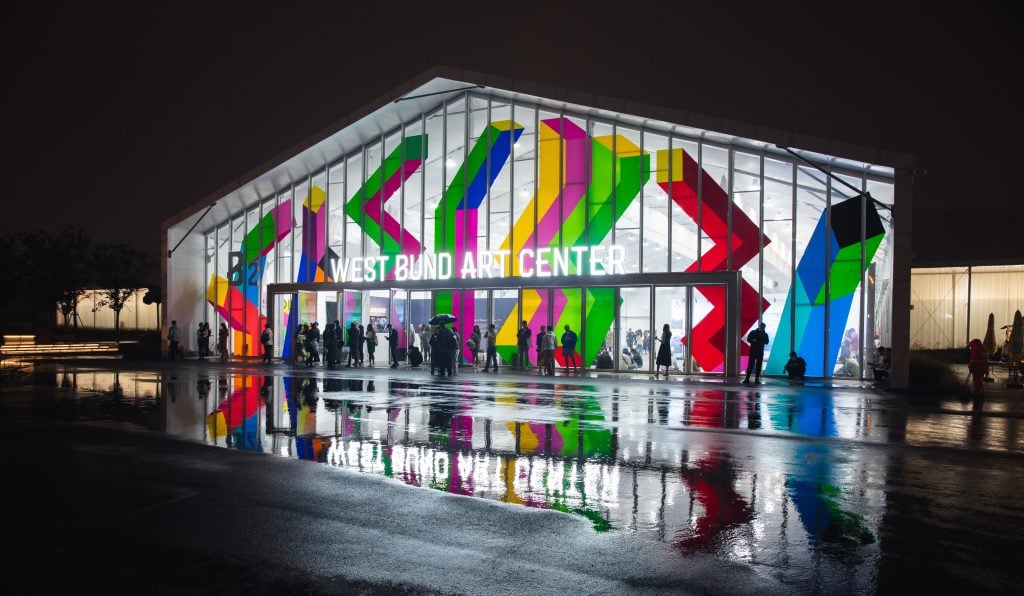
The fair served as a litmus test of sorts for the resilience of the Chinese art market.

Cathy Fan

Despite relentless rainy weather and strong winter winds, art enthusiasts flocked to Shanghai Art Week this year to take in the more than 200 exhibitions organized by local museums and galleries. The week was capped by the opening on November 9 of the city’s two major art fairs, West Bund Art & Design and ART021 Shanghai Contemporary Art Fair. As the city showcased its vibrant and energetic art scene, stakeholders used the occasion to check in on the sizeable market’s potential after the setbacks of recent years.
There were mixed emotions at both fairs. Factors such as the exodus of foreign residents and institutions from Shanghai, Hong Kong’s disappointing autumn auctions (notably the Long Museum collection sale), the collapse of the real estate industry, the closure of private art museums, stricter government censorship of contemporary art, and grim economic forecasts cast a palpable shadow.
West Bund Art and Design, however, celebrated its 10th anniversary with a remarkable comeback after 2022’s early closure. Its largest-ever edition hosted 185 exhibitors, including 54 galleries making their debut alongside veteran participants from established international galleries like Hauser and Wirth, Pace Gallery, and White Cube, and prominent Chinese galleries such as White Space, Aike, and ShanghArt Gallery.
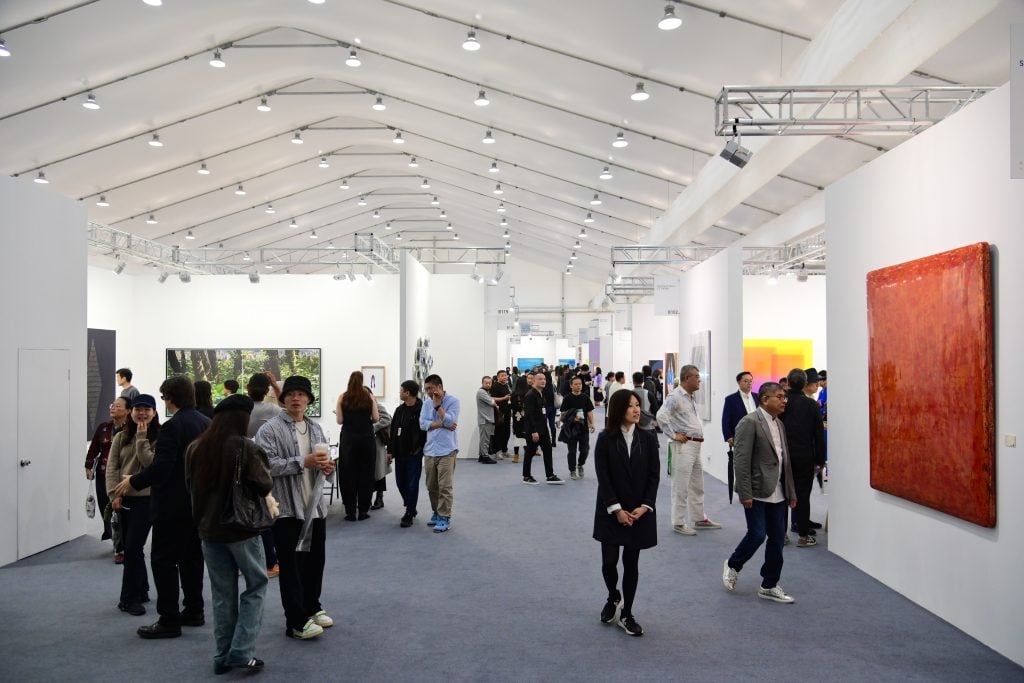
Visitors at the 2023 West Bund Art & Design. Photo: courtesy of West Bund Art & Design.
Before 2020, many galleries opted to take part in both fairs. West Bund is known for its “statement” booths of large-scale installations and videos, or carefully curated solo presentations, and it is believed to lure in more institutional collections. ART021, meanwhile, appeals to private collectors, particularly those new to the scene.
This year, however, the landscape has shifted. Only 23 galleries continue to straddle both fairs, and an increasing number of them are Chinese dealers.
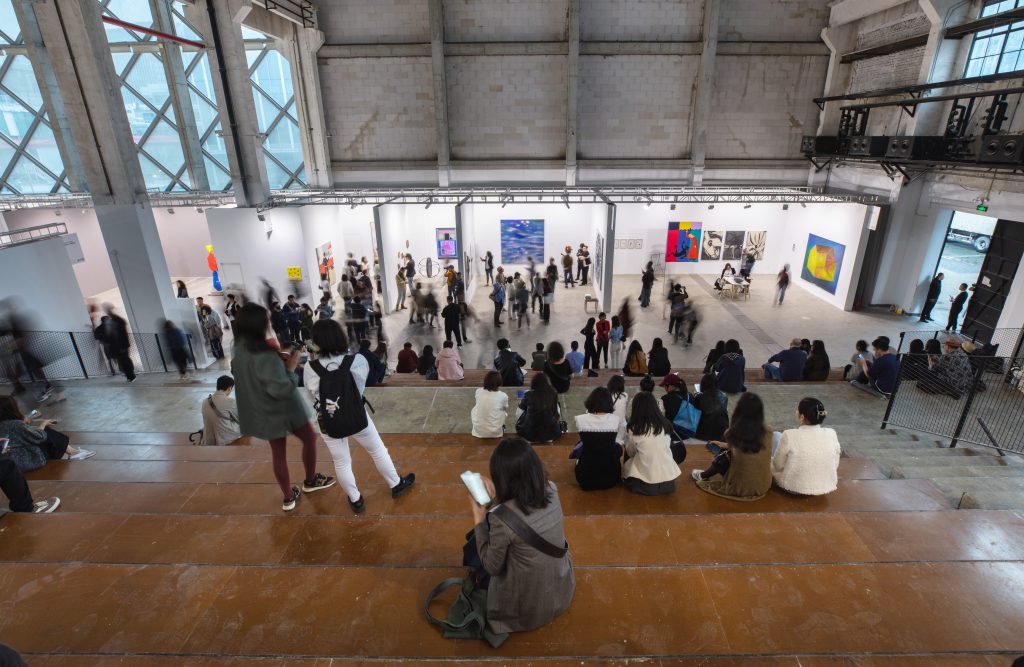
Installation view of 2023 West Bund Art & Design. Photo: courtesy of West Bund Art & Design.
The transformation of West Bund reflected the district’s remarkable growth in recent years. For the first time, galleries spread across four halls, including the fair’s traditional Hall A and B, the West Bund Dome Art Center, and the new Thomas Heatherwick–designed Orbit exhibition center, a swirling building designed for large-scale events. Visitors returning to the city after the three-year border closures imposed by China were struck by its transformation from a sparse collection of art galleries and institutions into a thriving business district, complete with high-rise buildings and major technology companies.
And despite the inconvenience of traveling between venues in the rain, attendees remained upbeat. Collectors were seen eagerly and openly discussing their target purchases before even entering the fair, although most came to the event with relatively moderate budgets. A collector from Guangzhou who was accompanied by a cohort of fellow art-buying friends, said that, as in previous years, she planned to spend one million yuan (around $150,000).
“Everyone I know has been very much looking forward to this Shanghai Art Week. I am very satisfied overall,” said the collector, who only shared her last name, Wang. “I saw many favorite works, but I also regret having to say goodbye to works that were too much beyond the budget. This year, I am taking more time in considering what I buy.”
For many seasoned collectors, the excitement extended beyond the art on view. They relished the return to a sense of normalcy in the art market, and the opportunity to reunite with their peers, particularly those from overseas.
And after three long years of limited travel, the appearance of foreign faces among the fair crowds was conspicuous, and Taiwanese and Cantonese accents stood out as much as Western voices. Klaus Biesenbach, the director of the Neue Nationalgalerie, was seen mingling with K11 founder Adrian Cheng, and Hong Kong art dealer Pearl Lam. Swiss mega-collector Uli Sigg participated in a panel discussion during the second day of the fair. Also spotted at the fair and at various Shanghai Art Week exhibitions were Magnus Renfrew, the co-founder of Singapore’s Art SG fair, and Wenmei Yiu, the secretary general of the Taiwan Art Gallery Association, who brought a significant contingent of the Taiwanese art scene with her.
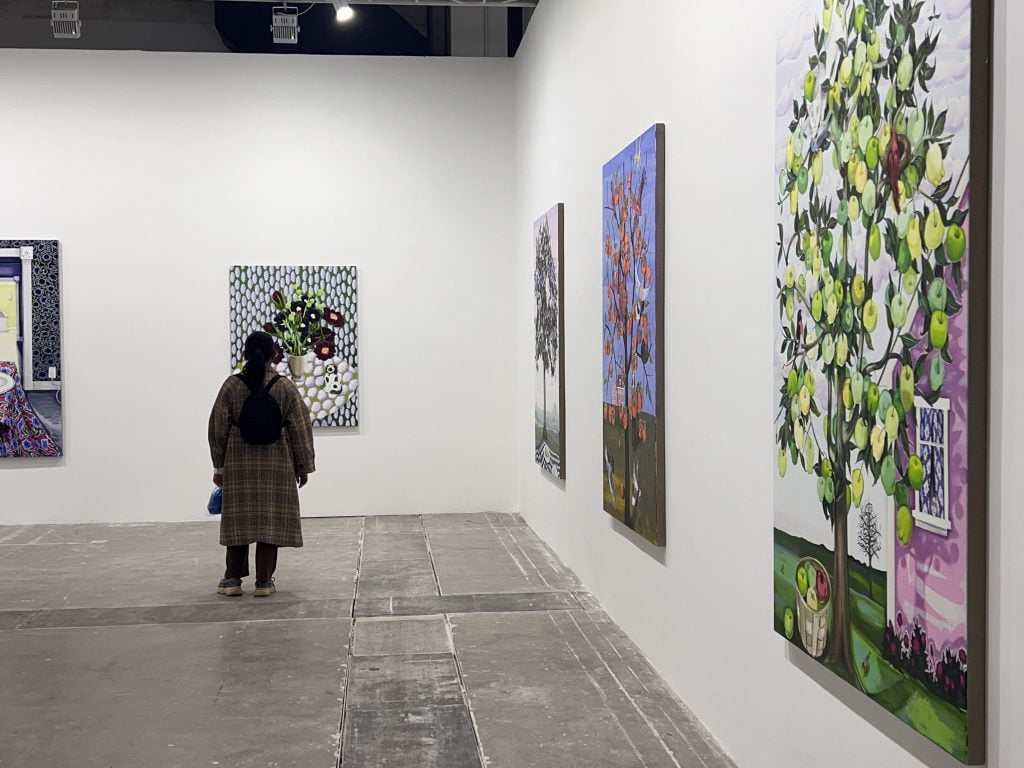
The booth of Perrotin gallery at the 2023 West Bund Art & Design. Photo: Cathy Fan.
Still, amid the excitement, critical voices sounded off in the lounge room. “The overall look is very conservative,” noted Hu Hu, a Shanghai-based art market consultant and founder of Art Jeff Club, of most the exhibitor’s presentations. “It’s almost all paintings, with scarcely any installations and sculptures, barely any video works.”
Florian Wojnar of Berlin gallery Esther Schipper, whose showed some sculptural works by artists like Ryan Gander, Philippe Parreno, and Ugo Rondinone, humorously recalled a collector’s relief at finding a booth not solely dedicated to paintings.
“There are indeed many visitors, but not enough ‘effective’ collectors,” Hu noted. This sentiment was shared among dealers, highlighting the challenge of expanding the city’s collector base.
The conservative trend was apparent not just in the artworks on display but also in the pricing strategies. In Hall A, most works were priced between $100,000 and $300,000, except for a few high-value pieces like Nicholas Party’s painting at Lévy Gorvy Dayan and Wei’s booth, listed at $900,000.
The strategy of lower prices and safe selections was relatively effective, judging by early sales in the main sector. In Hall B, where the younger and smaller galleries are concentrated, the prices are even more affordable, with most works ranging from $10,000 to $30,000, and some as low as $2,000. But these lower price points did not guarantee success, and some galleries reported that, despite the crowds, it was difficult to secure sales of works by unfamiliar, emerging artists, and their participation in the fair was not fully “paid for.”
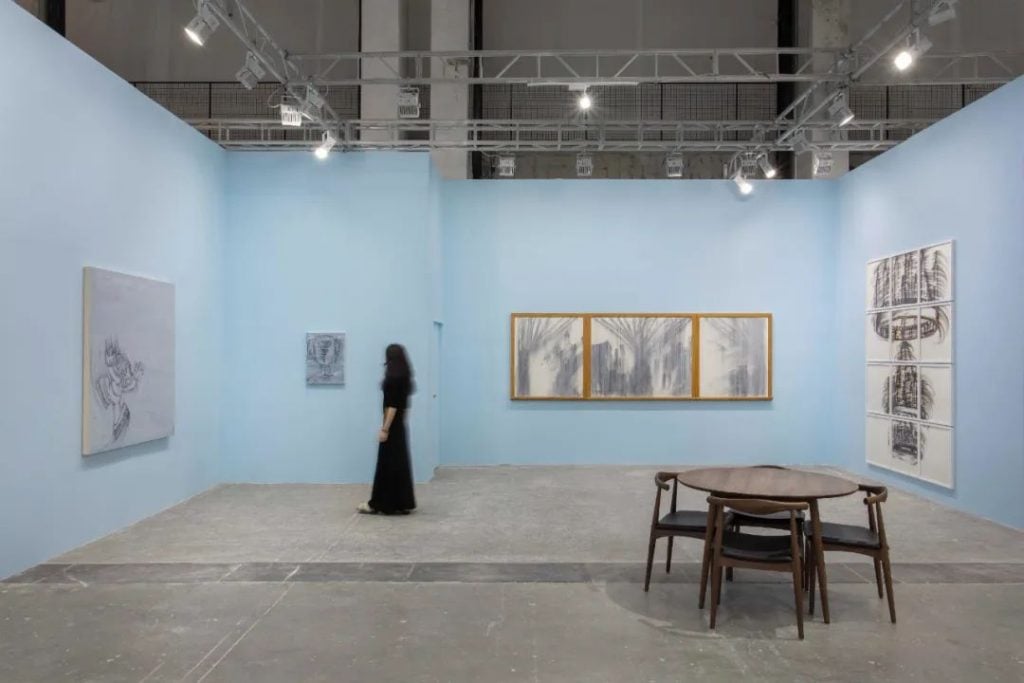
Hauser & Wirth’s booth at 2023 West Bund Art & Design. Photo: courtesy of West Bund Art & Design.
Some important sales were reported in the main halls, however. Perrotin’s booth featured intimate and somewhat dark figurative paintings by American artist Nikki Maloof (b. 1985), priced between $50,000 and $68,000, which received interest from many young collectors and were sold out on the fair’s first VIP day.
Hauser and Wirth continued their tradition of presenting curated solo booths at West Bund with a display dedicated to American artist Gary Simmons. Four of his paintings were sold to private collections on the first day, with prices ranging from $110,000 to $375,000.
And Gladstone’s large booth housed just three eye-catching, florescent sculptures from Ugo Rondinone’s “Magic Mountains” series, echoing the artist’s current solo show at Shanghai’s Fosun Foundation. All three works, priced at $420,000 each, were sold out on the fair’s opening day.

Gladstone’s booth at 2023 West Bund Art & Design. Photo: courtesy of West Bund Art & Design.
Lehmann Maupin sold 12 works, including McArthur Binion’s Vision: Ear (2023) for $250,000 and a piece from Lee Bul’s “Lost” series for $190,000.
Pace Gallery also reported decent sales, including two new paintings by Adam Pendleton, priced $150,000 each, a steel-and-lacquer sculpture by the duo Elmgreen & Dragset priced $95,000 to a private museum, an evocative abstract painting by Hermann Nitsch, Schüttbild, 2014 Juli, for $85,000.
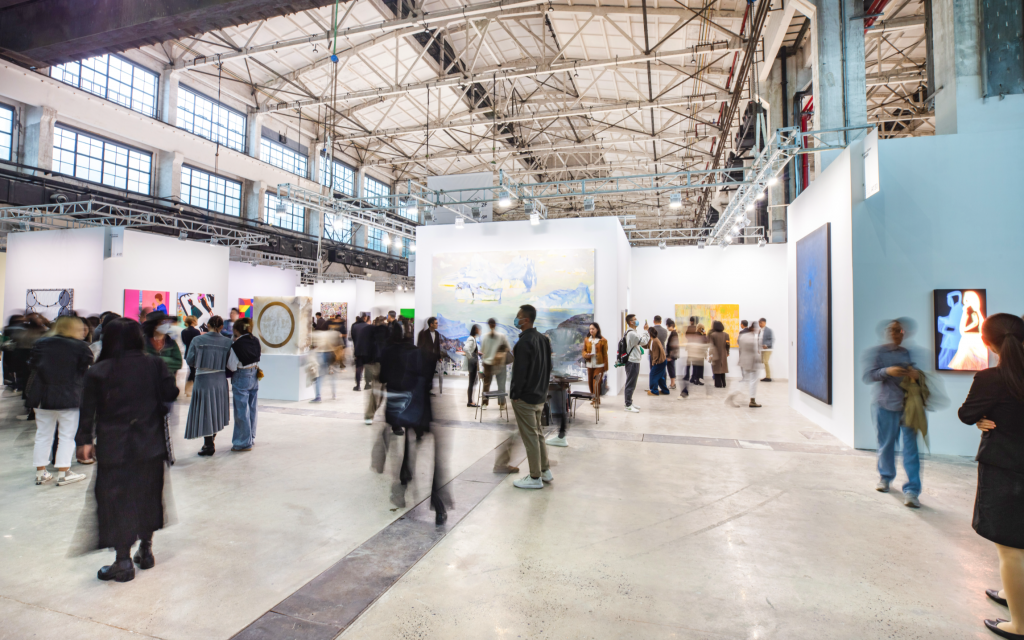
Visitors to the 2023 West Bund Art & Design. Photo: courtesy of West Bund Art & Design.
And China’s homegrown talent scout, the Hive Center for Contemporary Art, turned over their entire booth to the 43-year-old Chinese artist Xia Yu. “We are trying to concentrate resources more effectively to promote the influence of artists,” said gallery owner Xia Jifeng. “West Bund has a biennale-like temperament and is highly consistent with the creative practices of many of our artists.” A total of 14 works were sold, with larger pieces priced at 2 million yuan (around $274,300) and smaller works at 200,000 yuan ($27,430).
Still, domestic gallerists were more concerned about the questions lingering about the city’s art scene. In such an uncertain world, how will West Bund evolve in the next decade? And, perhaps more importantly, will the Chinese art market rebound or decline going forward?
No one had a clear view of the answer at this point, but longtime observers and participants provided some insights.
“The transformations within Chinese galleries might be the most substantial changes we’ve seen recently,” said Xia Jifeng, noting that, while it may take the market some time to catch up with these developments, “considering the broader Asian context, the depth of the Chinese market remains unparalleled and warrants thorough cultivation and development.”